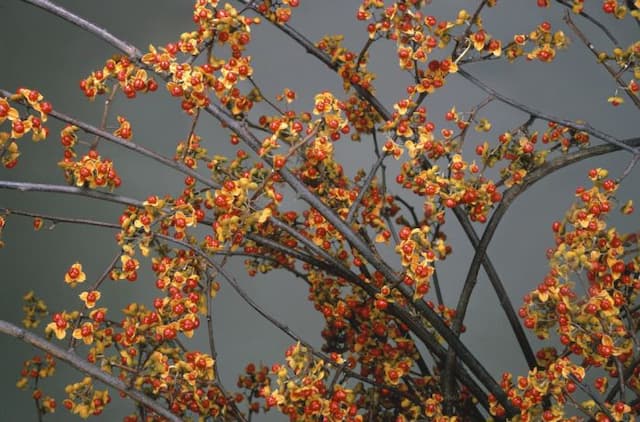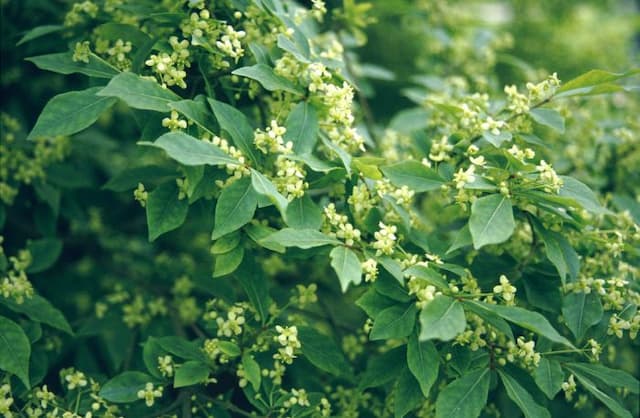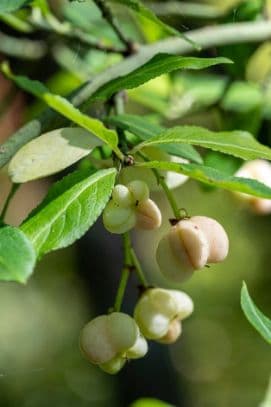Spindle Tree Euonymus carnosus 'Red Wine'

ABOUT
Euonymus carnosus 'Red Wine' is a visually striking plant characterized by its unique foliage and vibrant coloration. The leaves of this plant are a notable feature, with their broad, oval to elliptical shape creating a dense and lush appearance. During the growing season, the leaves emerge with a deep green color that serves as a backdrop for the plant's truly spectacular transformation in the fall. As the cooler months arrive, 'Red Wine' lives up to its name by showcasing a dramatic change in leaf color. The green foliage transitions to a deep, rich red wine hue, delivering a bold and dramatic visual impact in the landscape. This colorful display is further enhanced by the plant's glossy leaf surface, which reflects light and adds a luminous quality to the overall presentation. Adding to its decorative appeal, 'Red Wine' may produce small, inconspicuous flowers that are typically a yellowish-green color. Although not the main attraction, these flowers can contribute a subtle texture to the plant when they appear. Following the flowering period, the plant might bear fruit that takes the form of small, spherical capsules, adding another layer of interest to its appearance. Overall, the plant projects a robust and hearty look, with its full foliage and striking color changes making it a popular choice for those wishing to add a splash of vivid color to their garden palette. The contrast between the deep green leaves of spring and summer and the red wine-colored leaves of fall is a distinguishing feature that can create a focal point in any garden setting.
About this plant
 Names
NamesSynonyms
Red Wine Euonymus, Spindle Tree.
Common names
Euonymus carnosus 'Red Wine'.
 Toxicity
ToxicityTo humans
The Spindle tree can be toxic when ingested by humans. This toxicity primarily stems from certain compounds present in the plant such as alkaloids and glycosides. Symptoms from ingesting parts of the plant may include gastrointestinal disturbances like nausea, vomiting, and diarrhea. There can also be weakness, chills, a rapid heart rate, and in severe cases, it can lead to convulsions or significant complications that require medical attention.
To pets
The Spindle tree is also toxic to pets, such as dogs and cats. Ingesting parts of the plant can lead to symptoms similar to those in humans, including vomiting, diarrhea, weakness, and abdominal pain. In some cases, pets may experience more severe symptoms, such as muscle tremors, seizures, or heart problems, necessitating urgent veterinary care. It is critical to prevent pets from chewing on or ingesting this plant to avoid these potentially harmful effects.
 Characteristics
CharacteristicsLife cycle
Perennials
Foliage type
Deciduous
Color of leaves
Green
Flower color
Varies
Height
10-15 feet (3-4.5 meters)
Spread
6-10 feet (1.8-3 meters)
Plant type
Shrub
Hardiness zones
5
Native area
China
Benefits
 General Benefits
General Benefits- Ornamental Appeal: Euonymus carnosus 'Red Wine' adds aesthetic value to gardens with its deep red foliage, especially vibrant in the fall.
- Low Maintenance: It is known for being hardy and requiring minimal care once established, making it ideal for gardeners of all skill levels.
- Drought Tolerance: Once established, it has a good tolerance to drought, reducing the need for frequent watering.
- Wildlife Attraction: The plant can attract birds that feed on its fruit, adding natural activity to your garden.
- Versatility: The shrub can be used for hedging, as a foundation plant, or as part of a mixed border due to its manageable size and shape.
- Cold Hardy: It can withstand cold temperatures, making it suitable for growing in a variety of climates.
- Soil Adaptability: Euonymus carnosus 'Red Wine' can adapt to a range of soil types, though it prefers well-drained soil.
 Medical Properties
Medical PropertiesThis plant is not used for medical purposes.
 Air-purifying Qualities
Air-purifying QualitiesThis plant is not specifically known for air purifying qualities.
 Other Uses
Other Uses- Natural Dye: The leaves and berries of Euonymus can be used to extract natural dyes for textiles, producing a range of colors depending on the mordant used.
- Winter Garden Interest: The 'Red Wine' variety, with its deep red fall foliage, provides visual interest in winter gardens when most other plants have died back.
- Photography: Euonymus 'Red Wine' with its vibrant colors provides an excellent backdrop or subject for nature photography enthusiasts.
- Hedge Sculpting: The plant's dense growth habit allows it to be sculpted into various shapes for ornamental hedge designs.
- Educational Tool: Used as a learning tool for botany students to study leaf structure and color variation in plant species.
- Wind Barrier: Planted in rows, Euonymus can act as a windbreak protecting more delicate plants in the garden.
- Erosion Control: The root system of Euonymus helps to hold soil in place on slopes, reducing erosion.
- Cultural Symbolism: In some cultures, Euonymus may be used in symbolic arrangements or decorations due to its vibrant colors and seasonal changes.
- Fence Camouflage: The dense foliage can cover fences or unsightly structures in the landscape, blending them with the natural surroundings.
- Wildlife Shelter: Provides shelter and nesting sites for small birds and other wildlife within a garden ecosystem.
Interesting Facts
 Feng Shui
Feng ShuiThe Euonymus is not used in Feng Shui practice.
 Zodiac Sign Compitability
Zodiac Sign CompitabilityThe Euonymus is not used in astrology practice.
 Plant Symbolism
Plant Symbolism- Endurance: The Euonymus carnosus 'Red Wine', commonly known as Spindle Tree, is known for its hardy nature and ability to thrive in different environments, which symbolizes endurance and the ability to withstand life's challenges.
- Longevity: With its capability to live for many years, the Spindle Tree often represents longevity and the endurance of life over time.
- Protection: Spindle Trees have historically been used in hedges and boundaries, symbolizing protection and the creation of safe spaces.
- Versatility: Given the plant's adaptability to various conditions and the different ways its wood can be used, it symbolizes versatility and flexibility in life's pursuits.
 Water
WaterSpindle tree 'Red Wine' requires consistent moisture, but it's important to avoid overwatering. During the growing season, generally from spring through fall, water the plant thoroughly once a week with about 1-2 gallons depending on the size of the plant and the weather conditions; drier and hotter climates may necessitate more frequent watering. During winter, reduce watering to every other week or less, depending on your climate, allowing the soil to dry out slightly between waterings. Always check the top inch of soil for dryness before watering to ensure the plant actually needs additional moisture. Overwintering plants in colder regions may need even less frequent watering.
 Light
LightSpindle tree 'Red Wine' thrives in full sun to partial shade. The ideal spot for this plant is an area where it can receive at least 4-6 hours of direct sunlight each day, with dappled sunlight or partial shade during the hottest part of the afternoon, especially in very hot climates. This ensures vibrant foliage color and optimal growth. If the plant is situated in too much shade, its growth may become leggy and its leaf color may not be as intense.
 Temperature
TemperatureSpindle tree 'Red Wine' is temperate and prefers a range of temperatures between 50°F and 80°F for optimal growth. The plant can tolerate minimum temperatures down to about 30°F, and while it can survive brief periods of colder weather, prolonged exposure to temperatures below freezing can be damaging. The ideal conditions for the spindle tree include moderate temperatures and avoiding extremes of heat or cold.
 Pruning
PruningSpindle tree 'Red Wine' should be pruned to maintain shape, encourage bushier growth, and remove any dead or diseased branches. The best time to prune is in late winter or early spring before new growth begins. Pruning can be done annually, but it may not be necessary every year; observe the plant’s structure and only prune as needed. When pruning, make clean cuts and aim to create an open framework that allows light and air to penetrate the plant.
 Cleaning
CleaningAs needed
 Soil
SoilSpindle 'Red Wine' prefers well-draining soil with a moderate amount of organic matter. A suitable soil mix for Spindle 'Red Wine' can be composed of two parts garden loam, one part peat moss or compost, and one part perlite or coarse sand to ensure good drainage. The ideal soil pH for Spindle 'Red Wine' should be slightly acidic to neutral, ranging from 6.0 to 7.5.
 Repotting
RepottingSpindle 'Red Wine' should be repotted every 2 to 3 years or when it has outgrown its current container. Choose a pot that is 1 to 2 inches larger in diameter than the previous one to provide adequate room for growth. Repotting is best done in the spring or early summer.
 Humidity & Misting
Humidity & MistingSpindle 'Red Wine' thrives in average humidity levels common in most homes, which is about 40-50%. It does not require high humidity and can tolerate drier indoor environments, but it should not be placed near heating vents or other sources of dry heat which may lower the humidity excessively.
 Suitable locations
Suitable locationsIndoor
Place Spindle 'Red Wine' in bright, indirect light inside and water moderately.
Outdoor
Grow Spindle 'Red Wine' in partial shade to full sun, protect from extreme cold.
Hardiness zone
6-9 USDA
 Life cycle
Life cycleEuonymus carnosus 'Red Wine', commonly known as Spindle or Fleshly Spindle, begins its life from seed, which germinates in spring when soil temperatures increase. Seedlings establish a root system and grow their first true leaves, eventually maturing into shrubs with a dense, rounded form. The plant enters a vegetative stage, producing thick, leathery, dark green leaves. In late summer to early fall, inconspicuous greenish flowers appear, which give way to the distinctive pink to red capsules that split open to reveal bright orange seeds that attract birds, aiding in seed dispersal. Over the years, the shrub experiences repeated growth and dormancy cycles, with foliage turning a deep red-purple in fall before dropping its leaves in winter. This deciduous shrub reaches maturity within several years, living for decades and repeating its reproductive cycle annually.
 Propogation
PropogationPropogation time
Spring-Early Summer
Propogation: The most popular method of propagation for Euonymus carnosus 'Red Wine', commonly known as Spindle Tree 'Red Wine', is through semi-hardwood cuttings. This is usually done in the late summer. One would take a cutting of about 4 to 6 inches (10 to 15 centimeters) from the current year's growth, ensuring that there are at least two sets of leaves on the cutting. The lower leaves are removed and the cut end is dipped in rooting hormone before being placed in a well-draining potting mix. The cutting should be kept moist and in indirect light until roots have developed, which typically takes a few weeks to a couple of months.





![Spindle [Blondy]](/_next/image?url=https%3A%2F%2Fplants-admin.emdemapps.com%2Fimages%2Fplants%2F%2Fimages%2F604b642f54add.png&w=640&q=75)
